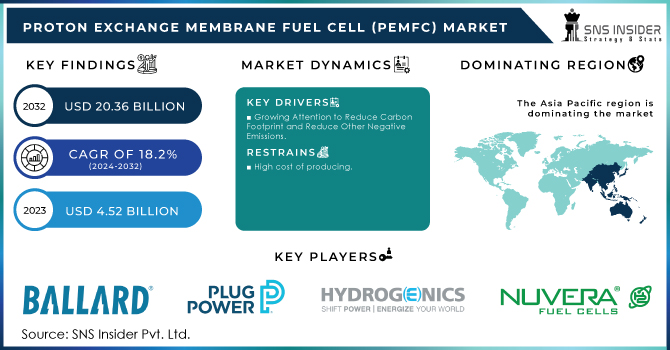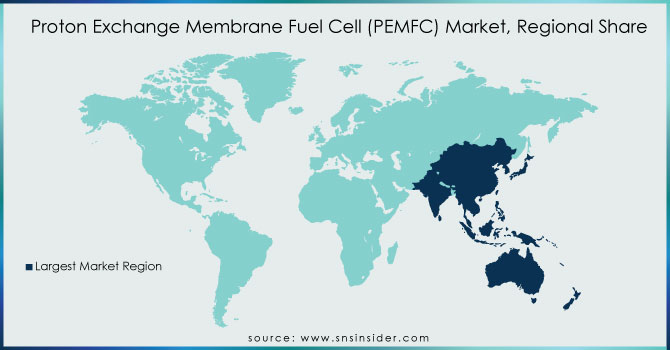Proton Exchange Membrane Fuel Cell (PEMFC) Market Report Scope & Overview:

Get more information on Proton Exchange Membrane Fuel Cell (PEMFC) Market - Request Sample Report
The Proton Exchange Membrane Fuel Cell (PEMFC) Market size was valued at USD 4.52 billion in 2023 and is expected to grow to USD 20.36 billion by 2032 with a growing CAGR of 18.2% over the forecast period of 2024-2032.
A hydrogen-based fuel cell called a proton exchange membrane fuel cell (PEMFC) is made up of a unique proton-conducting polymer electrolyte membrane. PEMFC can operate in temperatures between 50 and 1000 degrees Celsius. The main benefit that will propel the adoption of PEMFC throughout the predicted period is the reaction's sole water-based waste in the fuel cell. The fuel cell is regarded as the most ideal option for the transportation industry as a result of this feature.
The polymer electrolyte membrane (PEM) fuel cell, often referred to as a proton exchange membrane fuel cell (PEMFC), is a type of fuel cell that is primarily being developed for use in transportation as well as stationary and mobile fuel-cell applications. They have a specific proton-conducting polymer electrolyte membrane and a narrower temperature range, which are their distinguishing characteristics.
In contrast to PEM electrolysis, which consumes electricity, PEMECs create it. The PEMEC is a great option for mobile applications of various sizes, including mobile phones, due to its tiny size in other mobile and automotive applications.
MARKET DYNAMICS
KEY DRIVERS:
-
Initiatives towards developing hydrogen technology
-
Growing Attention to Reduce Carbon Footprint and Reduce Other Negative Emissions
-
Better Fuel Efficiency and Less Dependence on Fossil Fuels
Proton exchange membrane fuel cells are employed as a power source in a variety of fixed and mobile, as well as transportation-related, applications, which enables the global energy infrastructure to be strengthened and diversified. It offers a safe, dependable, and more energy-efficient way to meet the continuously expanding need for electricity. Therefore, over the projection period, the demand for these fuel cells across various application sectors would be driven by improved fuel economy and a trend towards the adoption of zero-emission automobiles.
RESTRAIN:
-
High cost of producing
OPPORTUNITY:
-
Technological Advancement
-
Lowering the percentage of platinum used in fuel cells
CHALLENGES:
-
High initial investments
-
Rising demand for other electric vehicles and managing bulk Hydrogen Fueling Stations.
The increasing demand for electric cars, including battery electric vehicles and plug-in hybrid Electric Vehicles, is the main factor that might limit the expansion of the proton exchange membrane fuel cell sector. Due to its numerous benefits, including improved efficiency, no harmful byproducts, cost-effectiveness, and energy security, the demand for these cars is growing significantly. This aspect could impede growth.
IMPACT OF RUSSIA-UKRAINE WAR
We demonstrate that overall energy expenditures (direct and indirect) for families have grown by at least 63% and perhaps as high as 118% (i.e., more than doubled) based on a range of energy pricing scenarios. Between 2.7% and 4.8% more is spent by households worldwide as a result of this. This is a significant change that is comparable to a major economic shock: households all over the world now need to find a few percent of additional income merely to maintain their quality of life from before 2022.
KEY MARKET SEGMENTATION
By Type
-
High Temperature
-
Low Temperature
By Material
-
Membrane Electrode Assembly
-
Hardware
-
Others
By Application
-
Automotive
-
Portable
-
Stationary
-
Others
REGIONAL ANALYSIS
Due to attempts by various governments in the area to develop and expand the hydrogen infrastructure, Asia Pacific has been the market's main region. Key industry companies are also present in the region, which has aided in their domination of the international market. Also, due to its government's strong desire to create a society free of carbon emissions and its enormous FCEV ambitions, Japan is expected to dominate the sector in terms of volume over the long term. Additionally, the administration is continuously developing frameworks and policies to meet the objective of creating a carbon-negative economy.
The U.S. is expected to grow exponentially in North America as a result of supportive government goals and significant investments in research and development. The administration has set ambitious aims to encourage the use of hydrogen-powered passenger cars, which are expected to increase regional demand for fuel cell vehicles. In order to lessen the nation's reliance on fossil fuels, governments like California have the vision to deploy commercial vehicles, particularly buses, during the anticipated period. Additionally, it seeks to reduce carbon footprint.

Need any customization research on Proton Exchange Membrane Fuel Cell (PEMFC) Market - Enquiry Now
REGIONAL COVERAGE:
North America
-
US
-
Canada
-
Mexico
Europe
-
Eastern Europe
-
Poland
-
Romania
-
Hungary
-
Turkey
-
Rest of Eastern Europe
-
-
Western Europe
-
Germany
-
France
-
UK
-
Italy
-
Spain
-
Netherlands
-
Switzerland
-
Austria
-
Rest of Western Europe
-
Asia Pacific
-
China
-
India
-
Japan
-
South Korea
-
Vietnam
-
Singapore
-
Australia
-
Rest of Asia Pacific
Middle East & Africa
-
Middle East
-
UAE
-
Egypt
-
Saudi Arabia
-
Qatar
-
Rest of Middle East
-
-
Africa
-
Nigeria
-
South Africa
-
Rest of Africa
-
Latin America
-
Brazil
-
Argentina
-
Colombia
-
Rest of Latin America
KEY PLAYERS
The Major Players are Ballard Power Systems (Canada), Plug Power (United States), Hydrogenics (Canada), Nuvera Fuel Cells, LLC (United States), Horizon Fuel Cell Technologies (China), Nedstack Fuel Cell Technology (Netherlands), ITM Power (United Kingdom), AVL (Austria), ElringKlinger (Germany), Intelligent Energy (United Kingdom), W.L. Gore & Associates (United States), Pragma Industries (France), Umicore (Belgium) and other players are listed in a final report.
RECENT DEVELOPMENTS
-
In August 2022, Toyota Motor North America (Toyota) and the National Renewable Energy Laboratory (NREL) signed a cooperative research and development agreement to build, install, and test a 1-megawatt (MW) solar power plant. NREL's Flatirons Campus is home to a proton exchange membrane (PEM) fuel cell power generating facility.
-
In April 2022, SFC Energy and FC TecNray, two German businesses, agreed to collaborate on the production of methanol-based fuel cells. as well as hydrogen in India. The business has disclosed plans to introduce the EFOY hydrogen fuel cell in India will significantly contribute to the achievement of the nation's hydrogen ambitions, including initiatives to create up to 5 million tonnes of by 2030, green hydrogen.
-
Panasonic Corporation said in October 2021 that it has created a 100% hydrogen fuel cell generator, which produces energy by combining oxygen and high-purity hydrogen in the air in a chemical process.
| Report Attributes | Details |
| Market Size in 2023 | US$ 4.52 Billion |
| Market Size by 2032 | US$ 20.36 Billion |
| CAGR | CAGR of 18.2 % From 2024 to 2032 |
| Base Year | 2023 |
| Forecast Period | 2024-2032 |
| Historical Data | 2020-2022 |
| Report Scope & Coverage | Market Size, Segments Analysis, Competitive Landscape, Regional Analysis, DROC & SWOT Analysis, Forecast Outlook |
| Key Segments | • By Type (High Temperature, Low Temperature) • By Material (Membrane Electrode Assembly, Hardware, Others) • By Application (Automotive, Portable, Stationary, Others) |
| Regional Analysis/Coverage | North America (US, Canada, Mexico), Europe (Eastern Europe [Poland, Romania, Hungary, Turkey, Rest of Eastern Europe] Western Europe] Germany, France, UK, Italy, Spain, Netherlands, Switzerland, Austria, Rest of Western Europe]), Asia Pacific (China, India, Japan, South Korea, Vietnam, Singapore, Australia, Rest of Asia Pacific), Middle East & Africa (Middle East [UAE, Egypt, Saudi Arabia, Qatar, Rest of Middle East], Africa [Nigeria, South Africa, Rest of Africa], Latin America (Brazil, Argentina, Colombia, Rest of Latin America) |
| Company Profiles | Ballard Power Systems (Canada), Plug Power (United States), Hydrogenics (Canada), Nuvera Fuel Cells, LLC (United States), Horizon Fuel Cell Technologies (China), Nedstack Fuel Cell Technology (Netherlands), ITM Power (United Kingdom), AVL (Austria),ElringKlinger (Germany), Intelligent Energy (United Kingdom), W.L. Gore & Associates (United States), Pragma Industries (France), Umicore (Belgium) |
| Key Drivers | • Initiatives towards developing hydrogen technology • Growing Attention to Reduce Carbon Footprint and Reduce Other Negative Emissions • Better Fuel Efficiency and Less Dependence on Fossil Fuels |
| Market Opportunities | • Technological Advancement • Lowering the percentage of platinum used in fuel cells |

